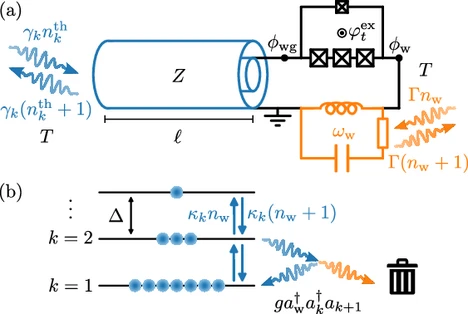Many-body Quantum Transport

(b) Through a three-wave-mixing coupling, the waste mode can transfer photons between neighboring modes, dissipating quanta of energy ∆ without changing the total photon number of the gas.
Non-reciprocal transport -where energy or particles preferentially move in one direction - is a key ingredient for applications such as quantum-limited amplification and detection. We explore environment-assisted non-reciprocal dynamics in superconducting circuits, using parametric three-wave mixing and engineered dissipation to achieve unidirectional energy transfer without magnetic fields. By coupling multiple resonators through nonlinear elements, we realize irreversible hopping of bosonic excitations mediated by their environment.
We recently proposed a bosonic cascade laser, where transport along the chain induces lasing in a coupled cavity mode. The feedback between chain and cavity gives rise to pulsed, avalanche-like dynamics, which can even be triggered by a single excitation - a feature with potential for ultrasensitive particle detection.
Another application we consider is quantum state preparation. By engineering non-reciprocal transport between the energy levels of a multimode resonator, we can accumulate excitations in a single mode, allowing us to achieve many-body states such as Bose-Einstein condensates of microwave photons.
People: Lukas Schamriss, Louis Garbe
Related publications:
Excitable quantum systems: the bosonic avalanche laser, L. Garbe and P. Rabl, arXiv:2509.05290 (2025)
The bosonic skin effect: Boundary condensation in asymmetric transport, L. Garbe, Y.Minoguchi, J. Huber, P. Rabl, SciPost Phys. 16, 029 (2024)